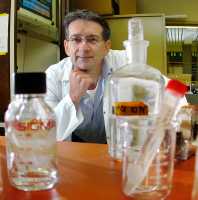 MedicalResearch.com Interview with:
Daniel Grenier, Ph.D.
MedicalResearch.com Interview with:
Daniel Grenier, Ph.D.
Professeur titulaire
Oral Ecology Research Group, Faculty of Dentistry, and Institute of Nutrition and Functional Foods, Université Laval
Quebec City, QC, Canada
Medical Research: What is the background for this study?
Dr. Grenier: Periodontal diseases (gingivitis and periodontitis) are major public health problems because of their high prevalence and incidence in all regions of the world. According to epidemiological studies, approximately 5% of North Americans suffer from severe generalized periodontitis, which can lead to tooth loss, while mild to moderate periodontitis affects up to 35% of adults. Given emerging data indicating that there is a relationship between periodontal diseases and systemic health problems such as diabetes, cardiovascular diseases, and preterm birth, studies on preventive and therapeutic strategies targeting periodontal diseases are highly relevant.
Medical Research: What are the main findings?
Dr. Grenier: Using various in vitro models, we brought clear evidence that a blueberry extract enriched in proanthocyanidins can act on the two etiological components of
periodontal disease. We first showed that these polyphenols inhibit the growth of
Fusobacterium nucleatum as well as its ability to form a biofilm, which can provide to the bacterium a resistance to antimicrobial agents and immune cells. Interestingly,
F. nucleatum has been associated with various forms of periodontitis as well as to a number of extra-oral infections, including endocarditis, inflammatory bowel disease, and brain abscesses. Moreover, the blueberry extract attenuated the inflammatory response of human macrophages challenged with
F. nucleatum, resulting in a decreased secretion of inflammatory cytokines (IL-1β, IL-6, TNF-α) and tissue destructive enzymes (MMP-8, MMP-9). Evidence was brought that this property is likely related to the ability of the blueberry polyphenols to block the activation of the NF-κB signaling pathway that play a key role in inflammatory reactions.
Over the last decade, my laboratory has been investigating the potential benefits of various classes of polyphenols for oral health. Polyphenols are a large group of natural substances found in plants and characterized by the presence of more than one phenol unit per molecule. Given that wild blueberries (
Vaccinium angustifolium Ait), a popular berry fruit in Quebec, are particularly rich in a specific class of polyphenols, called proanthocyanidins, we tested their effect on the two major etiological factors involved in the pathogenesis of periodontitis: a limited group of Gram negative anaerobic bacteria, and an uncontrolled host immune response to these pathogens that results in the secretion of high amounts of inflammatory mediators which modulate the progression and severity of periodontitis.
(more…)








